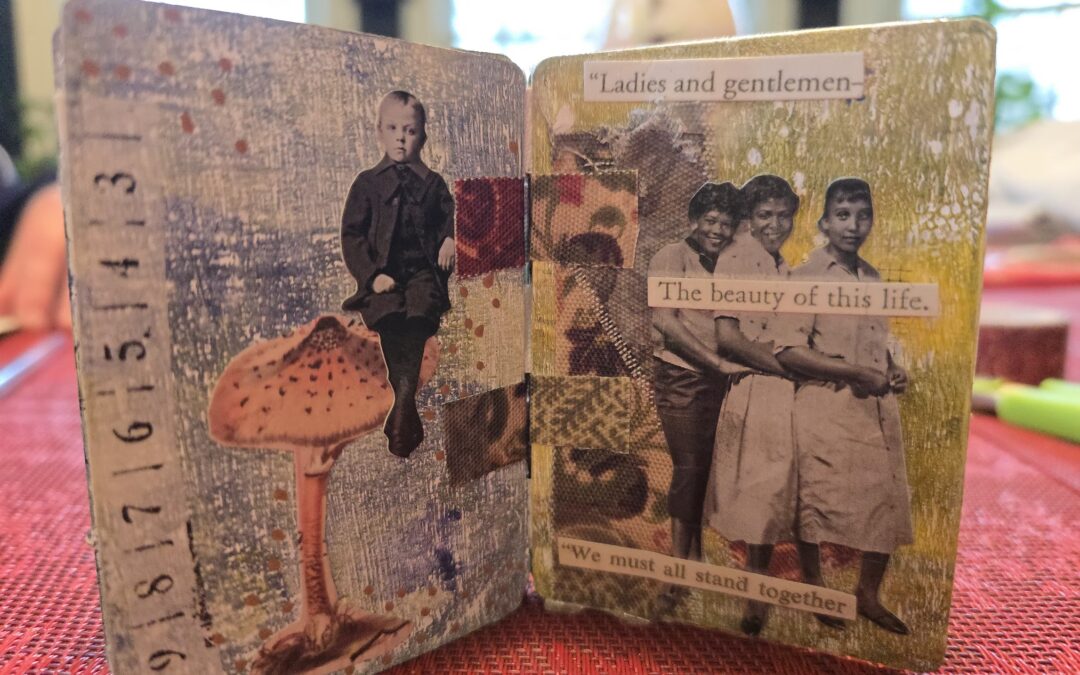I recently started work with a new private client, a male in his forties. Where I cannot share any personal details from our work together or any identifying info about him specifically, I can say from experience that art is a powerful antidote for many of life’s challenges—it’s also one of the most potent self-discovery and confidence-building tools at our disposal.
Not knowing anything about this client or what kind of art he might be interested in, I showed up to our first meeting with a curious mind and a bag full of project ideas. I had art journals, collaged canvases, 3D assemblage pieces, altered art, alcohol ink pieces, and handmade mini books made from things like playing cards, old cardboard boxes, and tags. During our meet and greet, he expressed a palpable interest in my mini book samples and shared that he would like to learn how to make one from playing cards. That’s what we worked on in our first few meetings together.
To say that I’m pleased with both the process and the outcome would be an understatement. Some might trivialize the artistic process and its benefits—which is an unfortunate side-effect of societal conditioning. I’m here to tell you: ART IS POWERFUL! It’s meaningful. It’s highly underrated. And it’s a necessary component in a fair and functioning society.
Working with a client 1:1 requires an elevated level of focus, care, intention, and advance preparation. I find myself utilizing a different skill set than the ones I use for my group classes and workshops. There’s also a unique blend of magic that emerges—one that becomes visually evident in the body of work that is created.
When one works to complete a project such as a mixed-media book from individual playing cards, there’s a plan, framework, and order of operations. You need to build layers, work with wet mediums first (typically), and create a visual story. It requires one to lean into their executive functioning skills and flex their working memory and cognitive flexibility muscles. Art is such a powerful tool for the neurodiverse!
You can’t possibly understand all the work that went into this project by simply looking at some photos—particularly if you don’t have a working understanding of mixed media art! There’s valuable EDUCATION in an artistic process. For example: my client (who frequently paints on canvas) learned about gesso for the first time. He learned a bit about color theory. He learned how to use a gel plate and brayer to make backgrounds that were both visually and texturally interesting and also added a cohesiveness to the overall project. He learned about creating layers and adding visual building blocks to this multi-layered project. We had some chicken and egg moments where some mistakes were made. He then used his cognitive flexibility to not get frustrated, but to utilize the errors as teachable moments and incorporate those “mistakes” into the final project.
Yes, the final result was amazing! But, even more than that—his pride was palpable! Largely unbeknownst to him at the onset, he became an alchemist—he transformed something (a deck of playing cards) into something else (a beautifully handmade book). He was a storyteller—he wove together visual imagery and words to tell a tale that had never been told before! And maybe even most importantly of all—he was brave and vulnerable. He was teachable and coachable. And, as the weeks went on, he found his voice, both literally and metaphorically.
When he completed the book last week, I had him sign his masterpiece and then we had a debrief.
I asked him what he learned.
💡 He said that he learned about “order.” As in the steps to take to create a project like this. He learned gel printing and about how to make things cohesive with color combinations. And, he said he learned how to “express emotions from words and supplies.”
I asked him what he liked about the process.
💡He said he enjoyed matching imagery with words and creating a story that way. He likes adding personal touches throughout the book. And, he found himself “thinking about his life while the art flowed.”
I asked him if he experienced any challenges/frustrations.
💡 He indicated that sometimes “matching” an image to a background was challenging. And he sometimes struggled to keep attuned to how he wanted the story to feel.
Why is it important to explore what was learned, liked, and frustrating? Because that’s art—and LIFE! We’re (hopefully) always learning, we might find life frustrating from time to time, but we always have the capacity to extract what we LIKE from a situation and do MORE OF THAT!
What’s next for this client? Well, he alluded to the fact that he’s kind of a collector and magpie (something we have in common). I’m encouraging him to use that skill as the basis for our next project. Stay tuned…


Great story. Art is the door. It opens you to the world and the world to you!♥️